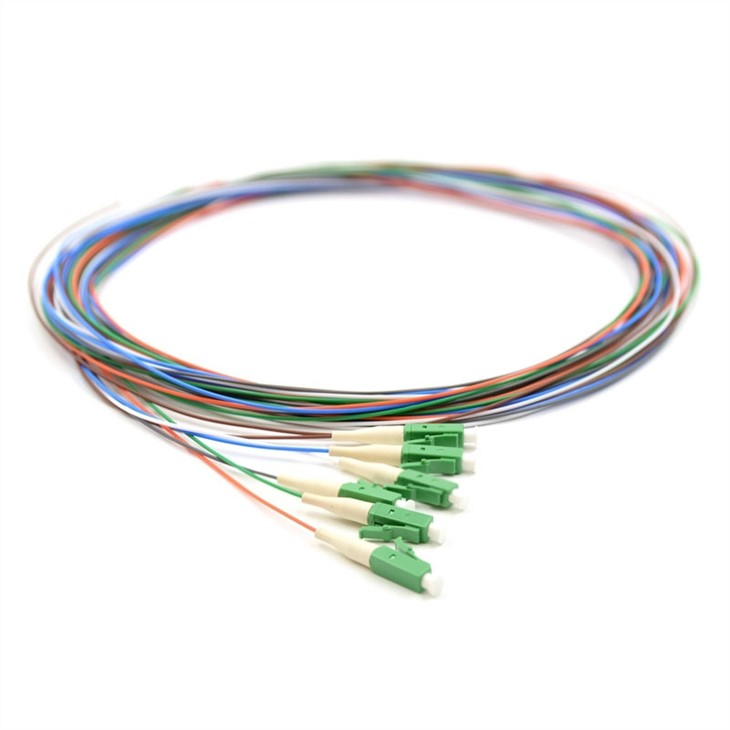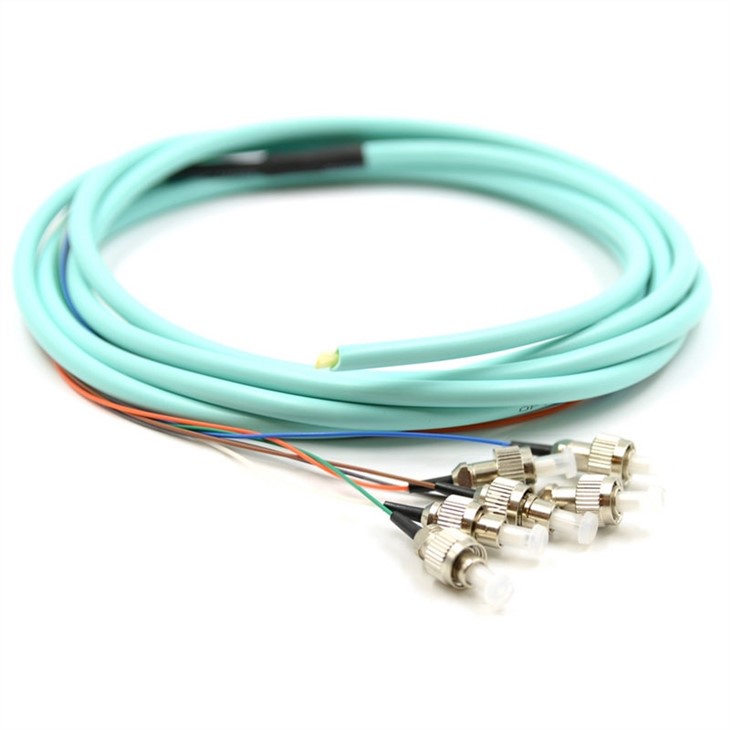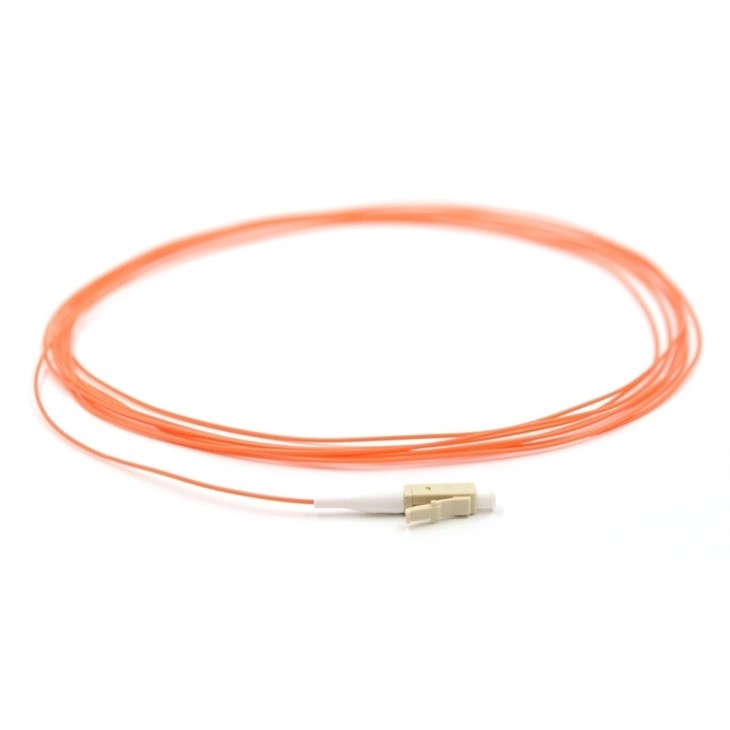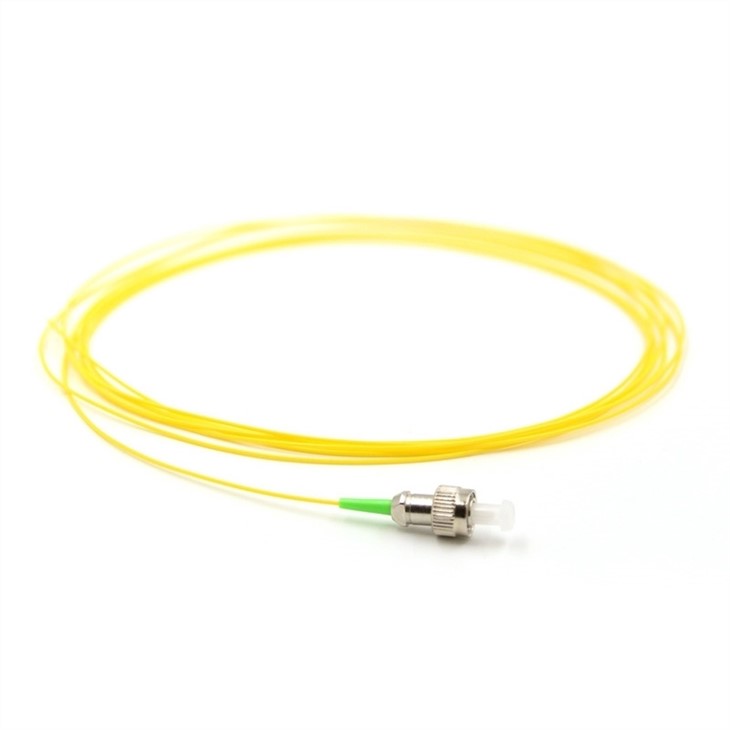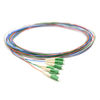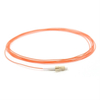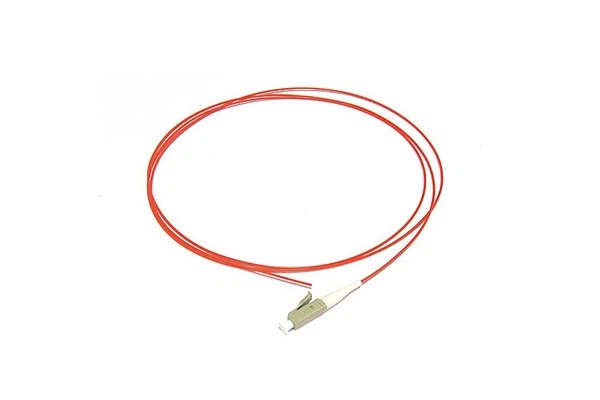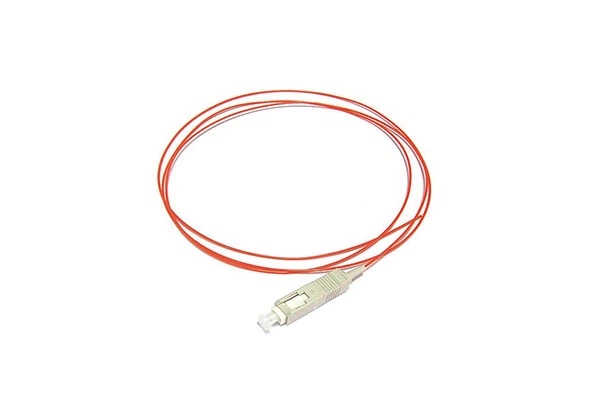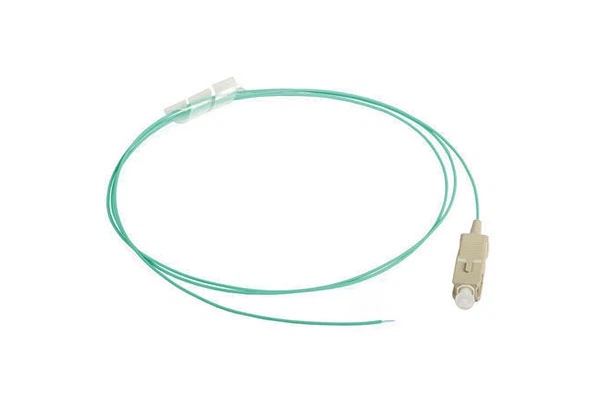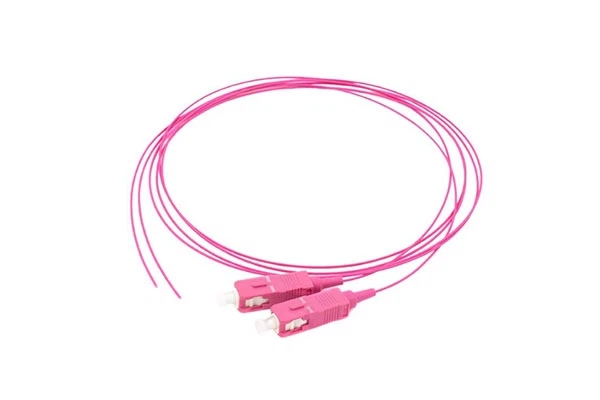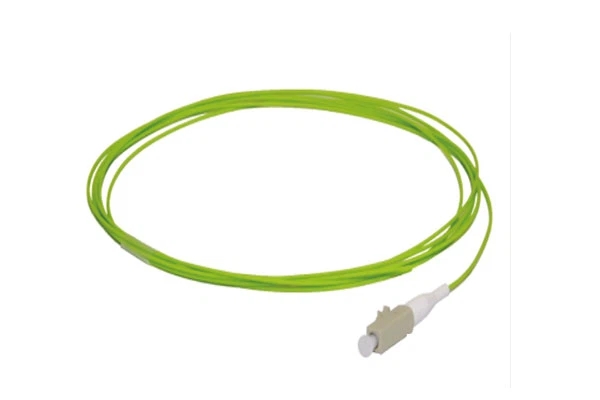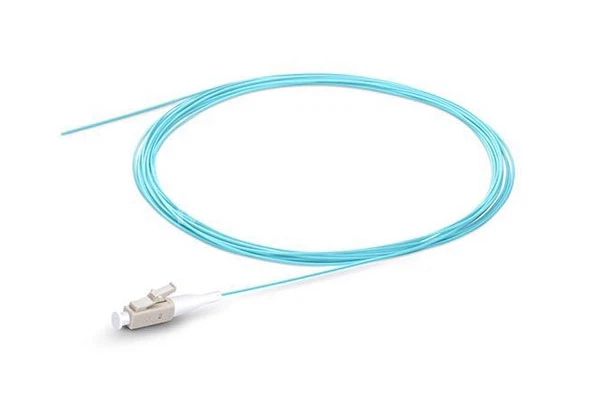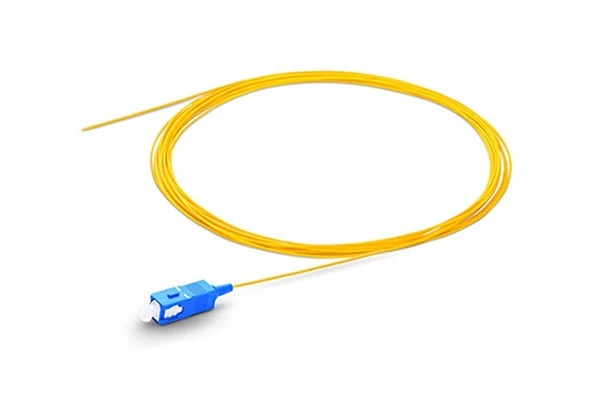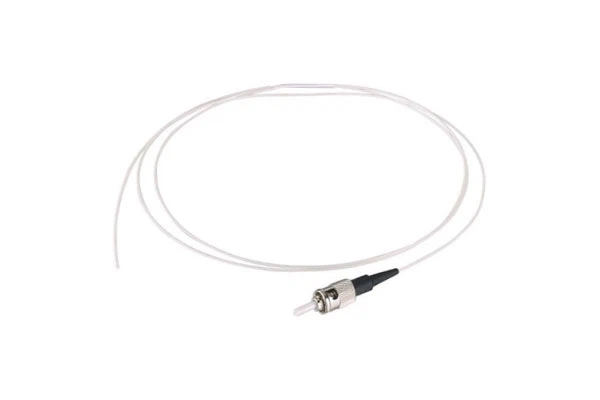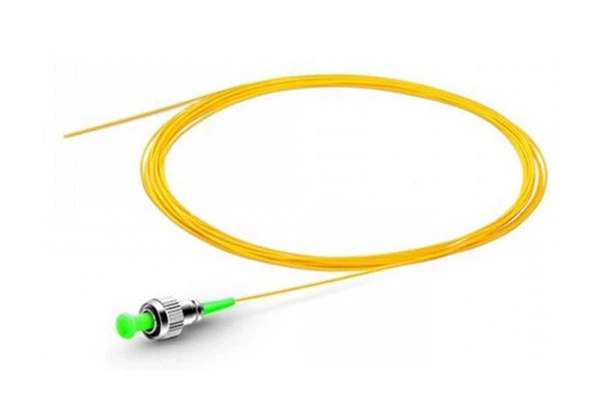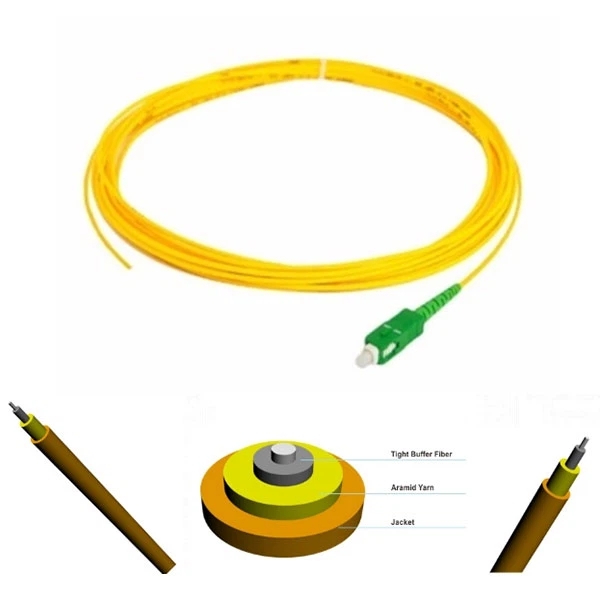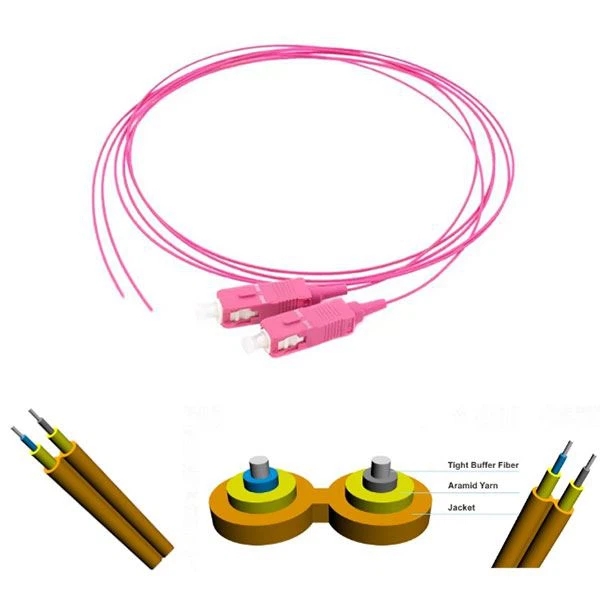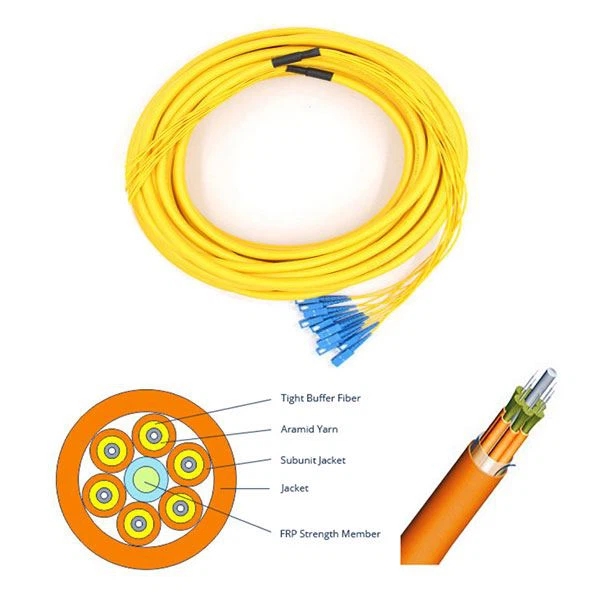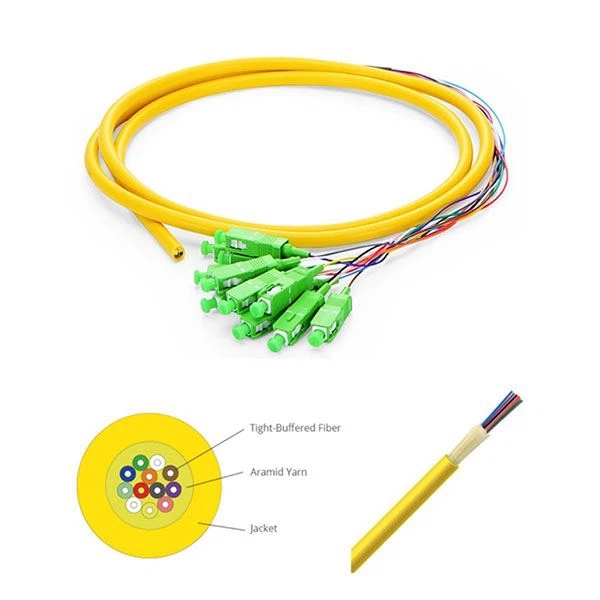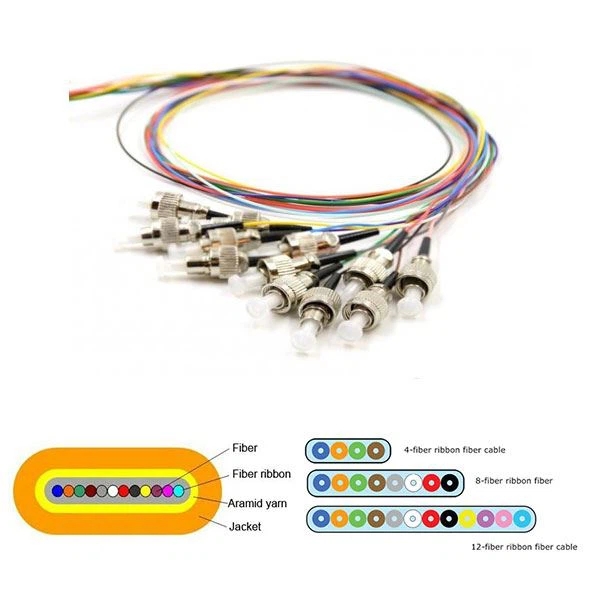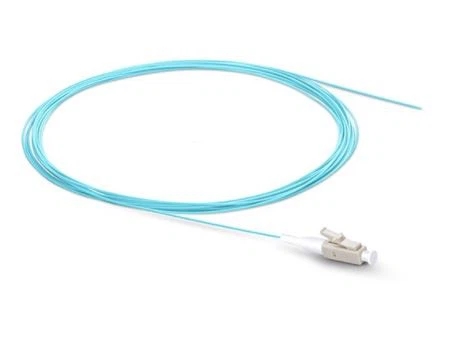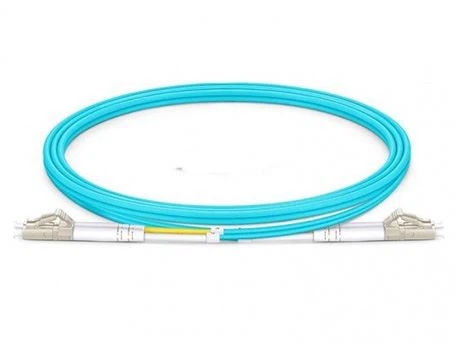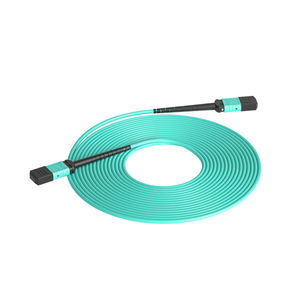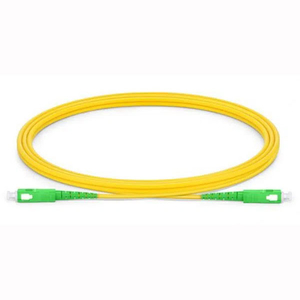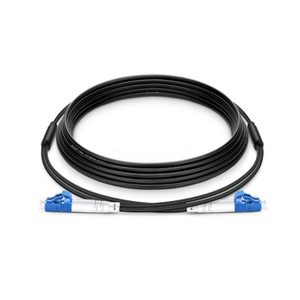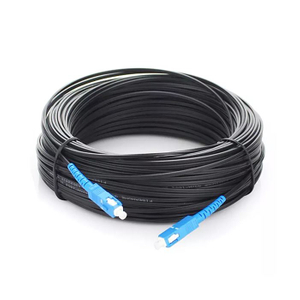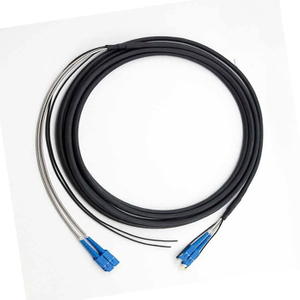TANGPIN, the leading fiber optic pigtail manufacturer in China, with over 3000 square meters factory based in Zhejiang, Jiaxing. We've specialized in R&D, manufacturing, marketing, and sales of optical pigtails for over 15 years. We wholesale customized optic pigtail at factory-direct-price according to customers' requests.
As an experienced exporter on fiber pigtails, we've served over 1000 customers from 100+ countries and regions in the telecom industry. Our main customers are telecom carriers, ISPs (Internet Service Providers), and telecom engineering companies in Europe, Asia, Africa, and North America.
Different from optical patchcord terminated connectors both ends, the fiber optic pigtail consists of a fiber cable terminated with a connector only one end. The terminated side is to connect equipment, and the other side is an exposed unterminated fiber to be fused or spliced with another optical fiber cable. Generally, the fiber pigtail is made into a single core, short and unbuffered fiber cable.
Tangpin Fiber Optic Pigtails Types
There are mainly four types of fiber pigtails, classified by different fiber types, different terminated connectors, different endface polish types, and different cable structures.
Classification by different fiber mode, there are two types of opitcal pigtails
✔ Singlemode Fiber (SMF) Optic Pigtail
✔ Multimode Fiber (SMF) Optic Pigtail
Single-mode fiber (SMF) and multimode fiber(MMF) both can be used for fiber optic pigtails. The SM fiber optic pigtail has a 9/125 micron core size. There are 2 types of SM fiber, OS1 and OS2. OS2 is the updated version based on OS1, now OS2 is commonly used in today's telecom industry. While multimode fiber is 62.5/125 micron of OM1, and the other is 50/125 micron of OM2, OM3, OM4 and OM5.
Singlemode Fiber (SMF) Optic Pigtail
Singlemode Fiber OS1 Simplex SC/UPC Pigtail
Yellow jacket
OS1 fiber pigtail is tight-buffered construction, which is usually used for indoor applications, such as campus or data center. The typical attenuation is 1.0 dB/km for OS1, with speeds from 1-10Gb/s at distances up to 2km.
SingleMode Fiber OS2 SC/APC Pigtail
Yellow jacket
OS2 pigtail are mostly used as loose buffered fiber for outdoor applications. The typical attenuation is 0.40 dB/km at 1310nm and 0.30 dB/km at 1550nm. The signal can normally travel up to 25km on this fiber (at 1310nm) and up to 80km at 1550nm.
Multimode fiber (MMF) Optic Pigtail
Multimode fiber is available in two sizes, 50/125 µm and 62.5/125 µm with a cladding diameter of 125 µm. Different from singlemode fiber for long distance transmission, Multimode fiber is mostly used in communication over short distances.
There are five types of Multimode fiber pigtail, OM1 pigtail, OM2 pigtail, OM3 pigtail, OM4 pigtail & OM5 pigtail, according toa ISO/IEC 11801 and EIA/TIA standards
OM1 LC/UPC Pigtail
OM1 fiber optical pigtail with a core size of 62.5 micrometers (µm), is orange jacket by default. For optical multimode fiber with 200/500MHz*km overfilled launch (OFL) bandwidth at 850/1300nm (typically 62.5/125um fiber which is now obsolete.)
OM2 SC/UPC Pigtail
OM2 optical pigtails are also coming with an orange jacket and Its core size is 50µm instead of 62.5µm. OM2 is for optical multimode fiber with 500/500MHz*km OFL bandwidth at 850/1300nm.
OM3 SC/UPC Pigtail
OM3 pigtail has a defaulted jacket color of aqua, with same core size of the OM2, 50 µm. It's for laser-optimized 50um fiber having 2GHz*km effective modal bandwidth (EMB, also known as laser bandwidth), designed for 10 Gb/s transmission.
OM4 SC/UPC Pigtail
OM4 pigtail share the same core size 50 µm and Erika Violet jacket, or Aqua color. It is a further improvement based on OM3, and it is for laser-optimized 50um fiber having 4.7GHz*km EMB bandwidth designed for 10Gb/s, 40 Gb/s, and 100 Gb/s transmission.
OM5 LC/UPC Pigtail
OM5 fiber is the newest type of multimode fiber, and it is backwards compatible with OM4. It has the same core size as OM2/3/4. The color of OM5 fiber jacket is lime green. It is designed for 40 Gb/s, and 100 Gb/s transmission.
Single mode (OS1, OS2 etc) cables are coded yellow. However, when purchasing single mode, always check the OS specification (OS1 and OS2) to ensure that the correct one is selected. Multimode cables are color-coded in aqua (also representing OM3 and OM4), and lime green for OM5. To avoid confusion between OM3 and OM4, violet colored jackets for OM4 were introduced in Europe by manufacturers.
Classified by fiber connectors, there are various types of fiber optic pigtails:
Fiber optic pigtails can be terminated with different types of foptic connectors on one end. According to the types of terminated connectors, optical fiber pigtails can be classified as LC fiber pigtails, SC fiber pigtails, ST fiber pigtails, FC fiber pigtails, MT-RJ fiber pigtails, and E2000 fiber pigtails. Their structure and appearance will be different.
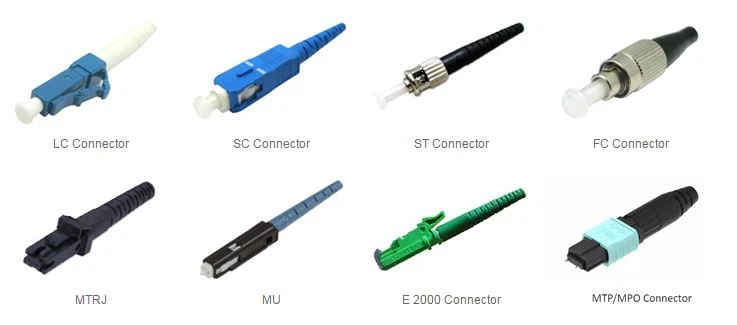
The most commonly used fiber optic connector types are SC, LC, ST, and FC.
LC optical pigtail
LC fiber optic pigtail uses LC conector. LC fiber optic pigtail is one of the most popular connectors in the world. A 1.25mm ceramic ferrule makes LC fiber optic pigtail a better choice for low cost but high precision signal transmission.
SC optical pigtail
SC fiber optic pigtail uses the SC connector. SC pigtail cable connector is a non-optical disconnect connector with a 2.5mm pre-radiused zirconia or stainless alloy ferrule. SC fiber pigtail are widely used in CATV, LAN, WAN, test and measurement.
ST optical pigtail
ST fiber optic pigtail uses the ST connector. ST pigtail connector is the most popular connector for multimode fiber optic LAN applications. It has a long 2.5mm diameter ferrule made of ceramic (zirconia), stainless alloy or plastic.
FC optical pigtail
FC fiber opitcal pigtail terminates the FC connector in one end. FC fiber pigtail takes the advantage of the metallic body of FC optical connectors, featuring the screw type structure and high precision ceramic ferrules.
According to the Difference in the type of connector polishing, there are connectors are of 3 versions, PC, UPC & APC. The UPC type has almost replaced the PC type. The insertion loss provided by APC is smaller than UPC, and APC types are more suitable for high-bandwidth applications and long-distance links, like Wavelength Division Multiplexing (WDM), Passive Optical Network (PON), and FTTx.
Classified by different types of fiber endface pigtails, there are mainly 2 types of fiber optical pigtails:
APC Fiber Optic Pigtail
“APC” stands for Angled Physical Connect. The angle of the ferrule end face is the 8-degree angle, which is very helpful for the tight connection of fiber end faces.
UPC Fiber Optic Pigtail
UPC connector is an upgraded version of PC. "UPC" stands for Ultra Physical Contact. UPC fiber connector evolved from the outdated PC connector.
The widely used versions are SC/APC pigtail, SC/UPC pigtail, LC/APC pigtail, SC/UPC pigtail, FC/APC pigtail, and ST/UPC pigtail, etc.
Classified by different cable structure, there are 6 types of patch cables:
Simplex fiber optical pigtail
simplex fiber pigtail, also can be called as one core fiber pigtail, which is one core fiber cable terminated with fiber connectors on one end, the other end is exposed.
Duplex fiber optical pigtail
Duplex fiber pigtail, also called 2cores optical pigtail, which consists of two fiber optical cable with a fiber connector terminated on one end, the other end is bare fiber with or without jacket.
Armored fiber optical pigtail
Armored fiber pigtails use rugged shell with aluminum armor and kevlar inside the jacket, and it is 10+ times stronger than regular fiber pigtail. The armored fiber pigtail is resistant of high tension and pressure.
Bundle breakout fiber pigtail
Bundle breakout pigtail, also known as fan-out pigtail, consists multiple fibers bundled around a central strength member. Each fiber has its own jacket and all of the fibers are packaged together inside the same outer jacket. The breakout fiber pigtail usually consists of 2.0mm tight buffered tube.
Distribution type fiber pigtail
Different from the breakout type pigtails, the distribution pigtail is smaller in size and lighter in weight. It usually consists of 0.9mm tight-buffered tube, inside where the cable are only bundled in a single outer jacket for protection, which made the distribution cable to be easily stripped for field termination.
Ribbon type fiber pigtail
Ribbon type fiber optic pigtail looks like a ribbon, and they usually consist of 8, 12, 24 or 48 fibers arranged side by side. It has a high fiber density. This type of pigtail can save a lot of space when space is limited, these features made them widely used indoor/outdoor point-to-point FTTx solutions and applications.
No matter the breakout pigtail, the distribution pigtail or the ribbon type pigtail, they are consisted of multiple fiber strands, it can be 4 fibers, 6 fibers, 8 fibers, 12 fibers, 24 fibers, 48 fibers and so on. This helps the effective interconnection and cross-connect in various applications. Due to the fiber optic pigtail are easily to be fused or spliced , it is often used with devices like optic distribution box, optical distribution frames, splice closures and cross cabinets. We offer customized pigtails for customers' requests.
Why Choose TANGPIN Fiber Pigtail
Cost-effective
Compared with purchasing from a trader or a distributor, purchasing directly from us can save at least 30% of the cost and eliminate many intermediate links.
Quick responsive lead time and flexible MOQ also help our customers to make more reasonable purchasing plans.
15 years manufacturing experience
2600 square meters of modern manufacturing factory, with 20 non-dust production lines, a powerful R&D and technical team of 20 technicians, a strong QC team of 8 engineers, 150 well-trained staff. The current monthly production capacity for fiber pigtails is 200,000 Pcs.
We've introduced and adopted the most advanced automatic alignment machine, fiber curing equipment, testing instruments, cutting and assembly machine, polishing equipment, ferrule glue injection machine & insertion/return loss tester, etc.
Guaranteed quality
All fiber pigtails are tested before shipping and also support 5-years Warranty.
Our factory has been certified with ISO9001 quality and environment management system and uses an advanced ERP management system. All our fiber pigtails are RoHS compliant.

Cutting edge testing equipment to ensure our fiber pigtails work more securely and data transmission is more reliable and stable in the network application.

24-hours services
24-hours-online professional pre-sales consultation, after-sales services & prompt feedback.
Customization Designs
Customization Designs service to integrate your own specifications.
Successful cases
TANGPIN has worked with over 500+ customers, and over 60% of our clients are telecom carriers & internet service, providers.
In our domestic market, we've contracted with some FTTH projects of China Mobile and China Telecom, and won some tenders, Zhengzhou Metro station project, Hunan Radio, and Television Broadcast Network projects & University town Project, and so on.
Our overseas customers are mainly from Southeast Asia, Europe, and Africa, such as Telkom, T-Mobile, AsiaCell, AWCC, PMCL, FiberNet, etc.
Part of our partners
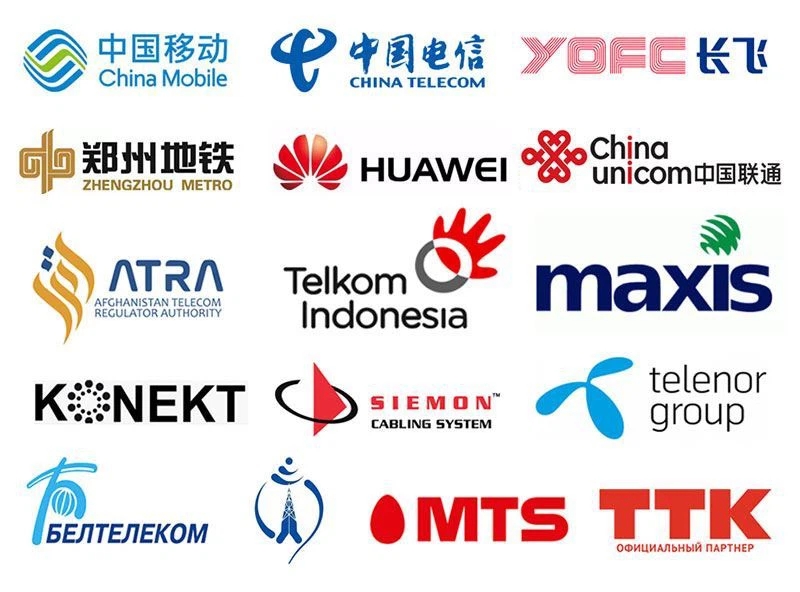
Fiber Optic Pigtail: The FAQ Guide
What is Fiber Optic Pigtail?
Fiber pigtail is an optical fiber with a factory-installed connector at one end and leaves the other end terminated. Thus, one side of the connector can be linked to devices and the other side can be melted with fiber optic cable. Fiber pigtail connects optical fibers by fusion or mechanical splicing. High quality pigtail cables, combined with correct fusion operation, provide the best possible performance for fiber optic cable terminations. Fiber optic pigtails are usually used in optical fiber management devices, such as ODF, optical fiber terminal box, and fiber optic distribution box.
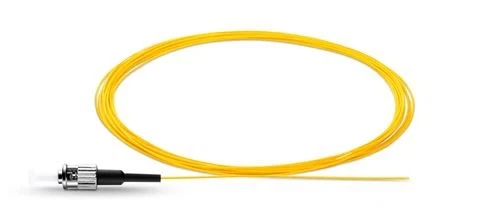
Fiber Optic Pigtail Features
Low insertion loss and return loss.
High precision ceramic ferrule, good concentricity
Traceable, standards-based testing procedures
Perfect for FTTX, Data Centers, and Data Processing Networks
Fiber Optic Pigtail color code
In order to identify individual fiber in a single fiber cable tube, we usually refer to the FTIA-EIA-598-A standard color code as follows:
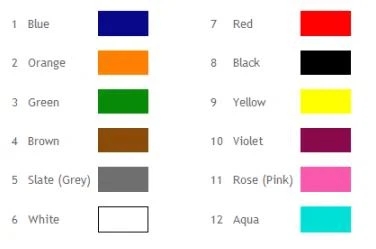
According to the TIA-598-A specification, for 13 or more fibers, the color code is repeated every 12, and stripes are applied every 12 buffer fibers or secondary cables.
Fiber Optic Pigtail splicing
Fiber optic pigtail quality is usually high since the end of the connection is factory installed, so it is more precise than field terminations. It can be fused or mechanically spliced attached to an optical fiber. Due to the use of a fusion splicer, it can be done in a minute or less, and greatly speeds up the splicing, and saves time and cost on field termination.
Mechanical fiber tail splicing is the precise joining of fiber pigtail, which can transfer light from one fiber to another temporarily or permanently. It would be better to purchase extra more in case of correction of splicing errors. In addition, choosing fiber optic pigtails of reliable quality can simplify the splicing process.
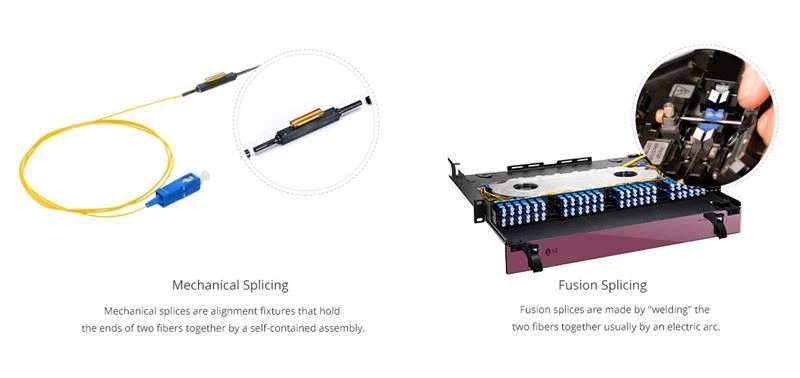
Fiber Optic Pigtail Application
Fiber pigtails are used to terminate fiber optic cables via fusion splicing or mechanical splicing, as shown in the following picture.
Pigtail end is stripped and fusion spliced to a simplex or a multi fiber trunk. Splice pigtail to each fiber in the trunk, "disconnect" the multi-fiber cable into its component fiber, and connect it to the terminal device.
High quality fiber optic pigtails combined with correct fusion practices provide optimal performance for fiber optic cable terminals.
99% of single-mode applications use fiber optic pigtail, but it is also being used in many multimode applications.
Advantages of using factory-terminated pigtails
Lower cost
Installers using single mode fiber usually have fusion splicer equipment. With splicers, installers can splice the pigtail directly to the fiber optic cable in a minute or less.
Factory guaranteed quality
Factory-tested insertion and return losses. Fiber pigtails are manufactured in a controlled environment and in high quality polishing equipment. Factory promises low insertion loss, high return loss.
What’s the Difference Between Pigtails and Patch Cords?
Only one end of the pigtail is installed with a connector and the other end is open. For fiber patch cords, connectors are installed at both ends.
Fiber Pigtail (unjacketed)
Fiber Patch Cord (jacketed)
Fiber pigtails are usually unjacketed, while fiber patch cords are usually jacketed. Fiber pigtails are often being spliced and protected in fiber splicing trays.
Fiber patch cords of simplex, duplex, 12 fibers, MPO patch cords
Fiber patch leads can be cut to make pigtails.
Normally it is difficult to test fiber pigtails in the field and to examine the ends before they are actually attached to the device.
To avoid this problem, some installers use an unsheathed fiber patch lead, test its performance, and then cut it in two as pigtails.
Datasheet
 Pigtail-spec.pdf
Pigtail-spec.pdf

